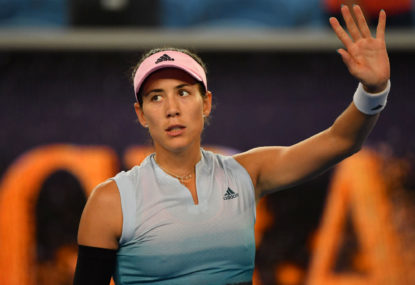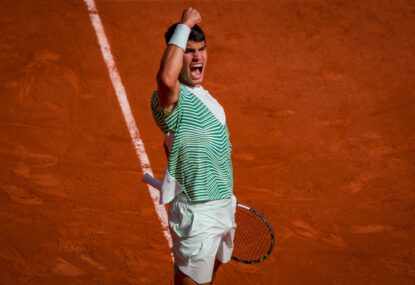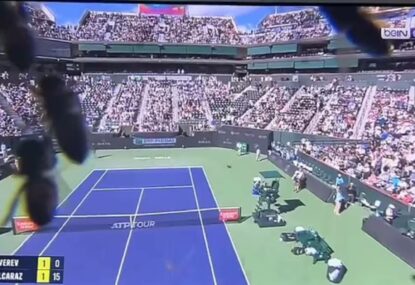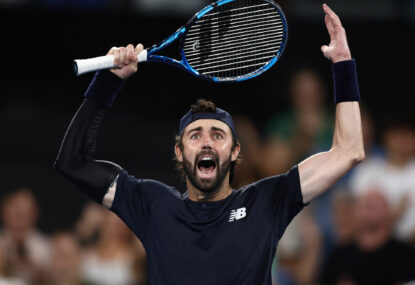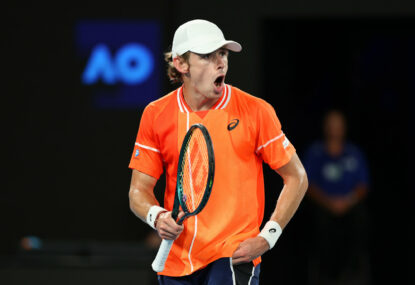Australia’s leading tennis players and national teams face a stern challenge in the next three months as the clay season begins in preparation for the French Open.
After the Masters tournament in Miami, the ATP world tour and ATP Challenger series turn to clay in the lead up to the second grand slam of the year.
The ATP world tour is all on clay with three Masters events in Monte Carlo, Rome and Madrid with the Challenger series having two-thirds of their schedule on clay as well.
Clay is also a theme for the national teams.
Australia plays Uzbekistan on clay in the second round of the Davis Cup Asia Oceanic zone as they fight for re-entry into the World Group, while the Fed Cup team will play Switzerland in late April on clay, as they attempt to bounce back into the world group after losing to Czech Republic earlier in the year.
So like it or not, Australian players will have to face up to clay if they are to maintain their ranking, or help Australia avoid further embarrassment for not qualifying for the World Groups.
This is bad news for many – except for Sam Stosur – who struggle on clay during this time of the year.
Here is how the key Australians stack up on clay:
In the men’s side of the draw, many struggle with playing on clay, with all struggling on the surface.
Australia’s current number one Bernard Tomic is 8 from 13 on the ATP world tour on clay and none from from on the Challenger circuit on the surface.
That’s a combined winning record of 44 percent on the surface, which isn’t too bad, but he has only made the quarter finals once on the surface. That was last season in Munich where he lost to Spaniard Feliciano Lopez.
Tomic is improving year on year on the surface but he will need bigger improvements this season on the surface if he is to be at his goal of the top ten by the end of the year.
The 2013 clay season will be a state of unknown for Marinko Matosevic who enters the clay season at his best ever ranking in his career at this time of the season.
He is 2-1 on the surface after joining Tomic in the quarter finals of the Munich event last season. Matosevic is 2-8 on the Challenger circuit, so you can suggest he may struggle on the surface as well.
The one shining light on the surface is Lleyton Hewitt who has a 96-48 record on clay in his career and Australia’s last title on the surface – Houston in 2009.
Hewitt – aided by a run of no injuries concerns – could be a revelation on the surface and a danger to many in the big tournaments. He is vital for Australia in success on clay and in the Davis Cup.
Finally, the clay season is important for Matt Ebden and John Millman for varying reasons.
Ebden has fallen down the rankings while Millman has surged up the rankings following a memorable summer.
Importantly for Ebden, he has no points to defend during the clay season, but his record and his match experience on the surface is poor.
He has only played only 10 matches on the surface in the ATP and has only won three times with them all coming on the Challenger circuit.
A big clay season for Ebden will see him bounce back towards the top 100 and into the French Open.
On the other hand, a big clay season for John Millman could bring him on the verge of the top 100 and an automatic berth at the French Open.
After winning two Challenger events in Burnie and Kyoto, Millman is at a career high ranking of 130 and is on the verge of the top 100.
He is the number one seed at the clay ATP Challenger event in San Luis Potosi and only has 21 points to defend between now and the French Open.
While he does have 60 points to defend in the ATP Challenger event in Busan, it will be after the calculations for the French Open, which will be huge for the Queenslander.
Millman has an okay record on clay at the ITF and Challenger level with the Australian 41-28 in the ITF circuit and 1-4 in the Challenger tour.
His success on the clay could lead to big success in the next few months for him.
The lack of overall success on clay for Australia sends major warning signs ahead of next week’s clash against Uzbekistan in Namagan.
In their last ten ties on clay, Australia has only won four, with those wins coming against teams that had players comfortably outside of the top 100 at the time.
I fear for Australia against Uzbekistan and with Denis Istomin and Farrukh Dustov in the team, they will be very hard to beat.
On the women’s side, much of the attention will be on Sam Stosur as she aims to finally win the French Open after being a finalist at the Grand Slam event in 2010.
While Stosur isn’t in the same form as her run in 2010, she will be a major threat on the surface.
As for the other Aussies in the WTA, all will be fighting hard to boost their ranking towards the top 100 with only Stosur guaranteed of a spot in the main draw at the moment.
Anastasia Rodionova (107), Casey Dellacqua (137), Olivia Rogowska (158), Ash Barty (188), and Jarmila Gajdosova (196) will all want to have good clay seasons to qualify for the second Grand Slam.
Out of these, Gajdosova is the best on the surface with a 90-53 record in her career. She will be looking to bounce back in the clay court season after a stuttering start to the season.
As for the others, it looks like Rodionova and Dellacqua will be the ones to look out for to climb up the rankings. Both have over 50 per cent records on clay and both will be looking to be in the top 100 before the French Open cut off.
The women also have an important Fed Cup tie on clay against Switzerland in late April with the girls doing well on the surface recently.
In the last four matches on clay, the Mosquitos have won three of those including a win last year against the Swiss.
With Gajdosova and Stosur in the team, Australia should win the match and qualify again for the world group.
Whatever happens in the next few months, one thing is clear, there will be plenty of talking points in relation to Australian tennis and success on the surface of clay.





























































































